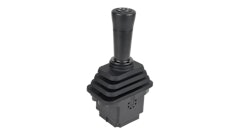In OEM Off-Highway's May 2008 issue, the "Fluid Power Series" story mentions several trends and changes affecting the design of hydraulic systems. According to the story, factors that fluid power customers consider important include: products that are lighter weight, able to handle higher pressures, routing systems through smaller spaces, and a greater use of O-ring seal connectors to prevent leakage.
Fluid power is one of the most important systems when considering what gets the work done at construction sites and other locations. Hydraulics are also used in braking, steering, machine articulation, stabilization, suspension systems and other functions within off-highway machines and equipment.
But as the space under the hood shrinks, design engineers must cram fluid power components into tighter envelopes. Electronic and electrical components, hot surfaces and other factors restrict routing of hydraulic lines and placement of hydraulic system components.
Smaller versions of existing hydraulic components are not necessarily the answer. Decreasing part sizes change mechanical and performance properties. Smaller components may also be more susceptible to shock and vibration, fluid impurities, temperature, and other imperfections that impede hydraulic system performance.
But a new approach to hydraulics called "microhydraulics" could change the way hydraulic systems are structured and integrated within off-highway equipment. It uses annular floating seals that double as valves.
When applied to hydraulics, the annular floating seal valves enable the creation of small, light-weight systems, one of which could fit in the palm of a hand. Despite their size, these systems are able to generate 10,000 psi pressures with flow rates of one half liter per minute.
How the technology works
Microhydraulics are hydraulic systems regulated by fluidics rather than conventional valves. Instead, they use the annular floating seals in combination with Bernoulli's principle to increase the velocity of a fluid and its kinetic energy, and decrease its static energy. At the heart of the technological breakthrough is the discovery that O-rings can be engineered to double as valves.
Traditional valves, pumps, and other conventional hydraulic components are eliminated from microhydraulic systems. Instead, cast manifolds contain all the necessary porting.
When incorporated into cylinders, like those used on off-highway equipment as actuators, the annular floating seal valves employ two mechanical subassemblies — a barrier and ram cap. With very small parts, these subassemblies work together as a regenerative hydraulic circuit that rapidly advances a cylinder's ram. Annular floating seal valves create the flow paths around pistons and ram rods. The seals are designed to work in the direction of rod travel.
The barrier and ram cap assemblies control the shift of the system into and out of the regenerative mode. It is a fully automatic process, which is regulated by the resistance encountered by the ram. In early designs, the cylinder's bulkhead separates the pump from the actuator. Current designs have the pump and actuator in a common manifold.
The rod side of the ram acts as the cylinder's reservoir. Working in combination with the ram cap, the barrier stops the flow of fluid from the reservoir to the accumulator, so the fluid displaced by the advancing ram is forced back through the ram cap into the ram chamber to create a regenerative circuit. The transition into and out of the regenerative circuit is instantaneous.
The ram is driven by the cross-sectional area of the ram-rod. As the ram engages its work, resistance and pressure build. At a predetermined pressure, the floating seal valve in the barrier squeezes off the surface of the seal plate, which opens the barrier gate. Fluid on the rod side of the ram is now pressed into the accumulator, and the ram is driven by the cross-sectional area of the ram cap.
Design advantages
Microhydraulic systems are self-contained and modular. Repair involves changing out a component without exposing the fluid to contaminants. Interfaces are only mechanical and/or electrical.
In addition to cylinders, annular floating seal valves can be configured to perform the functions of check valves, spring-loaded valves and bi-directional valves. The technology enables rapid closure with negligible backflow and no fouling. Off-highway products designed with the technology could be driven manually or via motor. Pressure from 100 psi to several thousand is regulated manually or with wireless technology.
The fluid used within the cylinders and other tools enabled by annular floating seal valves have high water content. The water-based fluid is four times less compressible than oil, which eliminates the "sponginess" and related challenges associated with other oil-based hydraulic fluids.
The water-based fluid has a low viscosity that reduces frictional losses. The high surface tension also keeps the water-based fluids from leaking. Additives provide lubricity, rust prevention, anti-freeze, and other desirable properties.
Microhydraulic technology minimizes the environmental risks of accidental fluid spillage and catastrophic disasters. Very small volumes of fluid, a lack of connections for potential leaks, and water-based fluids inherent in the technology are a "green" alternative to traditional fluid-based systems. These features also help make microhydraulic systems suitable for hazardous and hostile environments.
The technology can be used in places where compact, self-contained high-force linear actuators are needed. As high-force actuators, annular floating seal valves offer a compact and inexpensive alternative to hydraulic and pneumatic systems, eliminating the bulk and weight of hydraulic fluids and the noise of compressed air.
The elimination of hydraulic components results in fewer parts for increased system reliability while potentially doing the same work as traditional hydraulic systems.
Additional applications include the use of microhydraulic technology as the muscle for attachments, positioning actuators, automated equipment functions and other on-board hydraulic functions.
Bruce Wiebusch is a contributing editor from Cleveland, OH.
Microhydraulic licensing
Where to license annular floating seal valve technology
The FastFlow Syndicate is an independent member organization of industrial design engineers proficient in annular flow control and microhydraulic systems. They accelerate adoption of the technology through cross-licenses and collaborative developments.
Syndicate members are certified to engineer and design with the annular floating seal valves. They are also authorized to grant end-use licenses for the technology. The syndicate is currently looking for strategic partners and will collaborate with design firms on projects involving off-highway and other equipment. Commercial transactions include joint development agreements and licenses to use the intellectual properties associated with annular floating seal valves.
The syndicate provides application engineering to OEMs and other manufacturers of components and systems. Development efforts within the syndicate currently focus on electrically driven high-force microhydraulic actuators, wirelessly operated devices, and multi-ton compression and shearing tools.
The syndicate's purpose is to advance adoption of microhydraulic technology by promoting its use, establishing design standards, endorsing subassemblies and component designs, and bestowing FastFlow design certifications upon qualified practitioners. Design firms adopting the technology share in the royalties as FastFlow Syndicate members.
The syndicate has established strong intellectual property enforcement, economy of scope, and a broad-minded private labeling strategy. Open-innovation policies tying back to a competitive manufacturing complex will help thwart technology leakage.
For more information or a free disclosure package, contact LatchTool Group LLC, of Colorado Springs, CO: www.latchtool.com.















